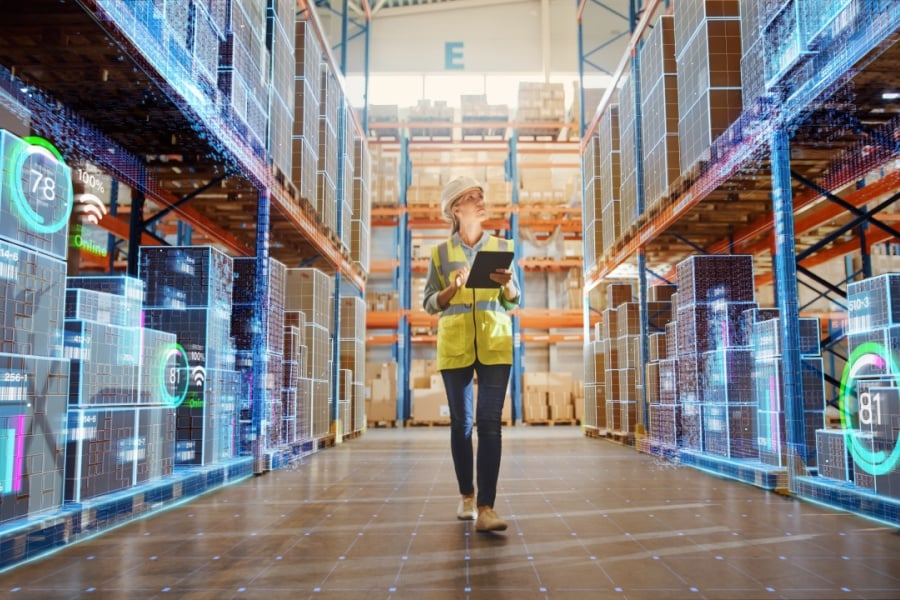Digital transformation is far more than a buzzword when it comes to tracing raw materials, products, and assets in the supply chain. One key lesson learned from the pandemic. The need for greater visibility and digitization of the supply chain.
Supply chain traceability is where a business has the necessary technology to track raw materials or finished products during every step of the supply chain.1 Inventory management, food and drug safety, regulatory compliance, warehouse staging, theft prevention, on-time delivery performance, and customer service are among the many reasons why companies need to more efficiently manage their supply chains with traceability systems.
Unlike order tracking, which focuses on the shipment delivery from the fulfillment center to the customer, supply chain tracing gives companies the potential to lot track/trace, control inventory and monitor assets, product or shipments within a facility or beyond its four walls in the field. Tracing is also enabled by enterprise and warehouse systems.
Supply chain traceability is at the forefront of the digital transformation initiatives undertaken by enterprises. A survey conducted in June 2022 to a small group of supply chain leaders by Peerless Research Group and Supply Chain 24/7 found that companies are turning to technologies such as sensors, barcode scanning, radio-frequency identification (RFID), camera imaging and GPS/cellular to better manage their supply chains.2
Within transportation and logistics, digitization initiatives include the ELD (electronic logging devices) used by the trucking industry, track and trace, customer order tracing, and order tracking technologies.3
Here’s a look at the technologies today that are being used to enable supply chain traceability:
RFID: backbone technology
RFID powers many supply chains and retail networks. The growth of RFID continues thanks to the rise of e-commerce, manufacturers and logistics providers. These are just a few examples of those using RFID technology to trace, secure and manage inventory. More robust than barcodes, RFID uses radio waves to communicate information between a reading device and an RFID tag that typically contains a small microchip and a radio antenna which communicates with the reader.
RFID tags can hold great amounts of information, from a single serial number to pages of data, depending on the type of tag. Tags give a unique identifier to each item with information updated while it moves along the supply chain to create an audit trail.
Some far-range wireless readers can cover as much distance as 1500 square feet and automatically gather data from low-cost passive tags without the need for scanning to discern the status of the product or shipment within the warehouse, giving real-time visibility.4
RFID systems vary widely depending on the provider, cost and type of tags used whether active, passive or semi-passive. Semi-passive and active RFID tags, for example, offer additional capabilities to help with tracking such data storage and extended communication ranges.5
With the right infrastructure and systems, RFID technology can provide tracing throughout a product’s lifecycle, from production to storage, transport and delivery. When battery-assisted tags aren’t deactivated at the point of sale or elsewhere they can even be used in product recalls or returns.
RFID systems are typically integrated with WMS, ERP and other enterprise systems, and while the core technology has been around for decades, RFID systems continue to advance and evolve.
Real-time visibility gets a boost
In recent years, RFID has combined with other technologies such as the Internet of Things (IoT) and big data to extend traceability. Assisted by IoT and edge computing, RFID tags are used to connect objects with a network, incorporating data that is read from the object and sent to the network.6
Fast-casual restaurant operator Chipotle has launched a pilot program that allows it to track and trace ingredients from the farm and supplier level to the table. The platform uses RFID and edge-to-cloud processing to bring RFID-labeled ingredients into its restaurants. By tracking ingredients, Chipotle can quickly respond to safety and quality issues, and provide customers with information about the source of every ingredient on its menu.7
Real-time locating systems
Location intelligence tracking systems often combine with RFID and other technologies to bring end-to-end visibility of the supply chain using GPS information. By aggregating supply chain data and applying machine learning, managers are armed with insights into the whereabouts and movement of assets and products. These systems mix location data with data from internal enterprise systems, IoT devices and external sources like vessel, air, ground and rail carriers.8
Real-time location systems (RTLS) blend a wide range of technologies such as ultrawideband (UWB) beacons, Bluetooth low energy (BLE) beacons, cellular networks, as well as traditional active and passive RFID to track and identify inventory, freight and assets.9
Real-time transportation visibility platforms (RTTVPs) are one form of real-time location systems that provide real-time insights into orders and shipments once they have left the warehouse or facility. RTTVPs typically use data from dedicated GPS and telematics hardware located on the truck, trailer or container which requires integration with carrier systems.10
Some advanced tracking systems extend visibility of the product to track not only the location of the shipment across modes—whether the item is on a truck or van on a remote road, on a cargo ship, in the yard or warehouse—but the condition of the product. In addition to real-time location information, these real-time locating and tracking systems use sensors which are applied to the object, packaging or container to send temperature, spoilage, damage, and tamper signals.11
The first-hand sensor data and other intelligence from data sources that include elements like the chain of custody information, route history, and risk history, truly combine to give parties in the supply chain actionable real-time information as they monitor shipment conditions and arrival times. Managers can receive event triggers remotely from sensor tags when pre-set parameters aren’t met to dynamically manage the supply chain, such as when a container door has been opened or temperature thresholds have been breached.
This means that businesses can manage expectations proactively when a shipment is delayed in transit, diverts from its route, or even in the case of theft by locating stolen merchandise when the shipment has gone awry. During transit, drivers can automatically be notified to remedy a situation. Such ability to monitor products is especially valuable for high-value goods like electronics or luxury automobiles, time-sensitive or perishable products.
Blockchain
The blockchain has nearly unlimited applications for logistics and the supply chain with product traceability a key driver when permanent, undisputed digital records are created. In simple terms, blockchain uses a completely decentralized ledger of transactions that are distributed across a computer network.
Many large companies are taking on blockchain, starting with one or two supply chain areas. Ikea, Home Depot, diamond company De Beers and luxury brand LVMH Group use blockchain to record product sourcing and transaction information, verify and manage supplier relationships and contracts, comply with industry regulations, track customer records and provide authentication to consumers.
Indeed, the benefits of digital ledger technology and the massive amounts of data it holds are far-reaching and include data security and accuracy. Blockchain is already beginning to transform supply chain traceability in sectors like food and produce. Such digital records can be used to verify that sustainability and ethical standards claims are met, such as in the beauty industry.
Among its many blockchain initiatives, global retailer Walmart uses an IBM platform to trace the origins of mangoes sold at its U.S. stores, and track supplies of pork in its China stores.12
Deloitte noted: “Blockchain driven innovations in the supply chain will have the potential to deliver tremendous business value by increasing supply chain transparency, reducing risk, and improving efficiency and overall supply chain management.”13
For the supply chain, blockchain brings increased traceability, improved quality, reduced losses from the counterfeit and gray market, and increased compliance to name a few efficiencies.




